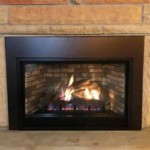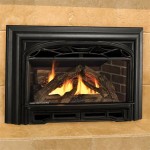Wood Stove Inside Fireplace: Considerations and Benefits
The concept of installing a wood stove within an existing masonry fireplace is a popular choice for homeowners seeking to enhance heating efficiency and reduce reliance on traditional fireplaces. This combination offers a balance of aesthetic appeal and practical functionality, though several factors must be carefully considered before proceeding with such an installation.
A traditional open fireplace, while visually appealing, is notably inefficient when it comes to heating a home. A significant portion of the heat generated escapes up the chimney, resulting in a net heat loss for the room. Wood stoves, on the other hand, are designed to burn wood more completely and efficiently, retaining a greater percentage of the heat within the living space. By integrating a wood stove into a fireplace, homeowners aim to capture the aesthetic charm of an open hearth while benefiting from the superior heating capabilities of a modern wood-burning appliance.
This article will explore the key considerations, benefits, and potential drawbacks associated with installing a wood stove inside a fireplace, providing a comprehensive overview for those considering this heating solution.
Assessing Fireplace Compatibility
Before purchasing a wood stove intended for fireplace insertion, a thorough assessment of the existing fireplace is crucial. Several aspects need careful evaluation to determine if the installation is feasible and safe. The dimensions of the fireplace opening, firebox depth, and chimney structure are all critical factors.
The physical size of the fireplace opening dictates the maximum dimensions of the wood stove that can be accommodated. The stove must fit comfortably within the opening, allowing sufficient clearance for proper air circulation and ease of access for loading wood and cleaning the stove. Insufficient clearance can lead to overheating and potentially dangerous conditions.
The firebox depth is equally important. The stove must be positioned far enough into the firebox to allow for proper flue connection and prevent smoke from entering the room. Additionally, the firebox should be structurally sound and free from cracks or weaknesses that could compromise its integrity under the increased heat generated by the wood stove.
The chimney's condition is perhaps the most critical aspect to evaluate. A properly functioning chimney is essential for safely venting combustion gases. The chimney should be inspected for any signs of damage, such as cracks, crumbling mortar, or blockage. A professional chimney sweep should perform a thorough inspection and cleaning to ensure the chimney is structurally sound and free from obstructions.
Furthermore, the chimney liner must be appropriately sized for the wood stove. Often, the original fireplace chimney liner is too large for the smaller flue outlet of a wood stove. This can lead to inadequate draft, resulting in smoke spillage into the room. In such cases, a new, appropriately sized chimney liner must be installed to ensure proper venting. Building codes often mandate that a stainless steel liner be installed when a wood stove is connected to an existing masonry chimney.
Evaluating Wood Stove Options
Once the fireplace has been assessed and deemed suitable for a wood stove insert, the next step involves selecting the appropriate wood stove model. Several factors should influence the selection process, including heating capacity, efficiency, emissions standards, and aesthetic preferences.
Heating capacity is typically measured in British Thermal Units (BTUs). The BTU rating of the wood stove should be matched to the size and insulation of the area to be heated. A stove with insufficient BTU output will struggle to maintain a comfortable temperature, while an oversized stove can lead to overheating and uncomfortable conditions. Calculating the heating load of the room or home is essential in selecting the correctly sized appliance.
Efficiency ratings indicate how effectively the wood stove converts wood into usable heat. Higher efficiency ratings translate to lower fuel consumption and reduced heating costs. Look for stoves with high efficiency ratings, often expressed as a percentage, to maximize the return on investment and minimize environmental impact.
Emissions standards are another crucial consideration. Modern wood stoves are designed to produce significantly lower emissions than older models, contributing to improved air quality. The Environmental Protection Agency (EPA) sets emissions standards for wood stoves, and homeowners should choose stoves that meet or exceed these standards. EPA-certified stoves are significantly cleaner burning and help to reduce particulate matter pollution.
Aesthetic preferences also play a role in the wood stove selection process. Wood stoves are available in a variety of styles, finishes, and materials. Homeowners can choose a stove that complements the existing décor and enhances the overall aesthetic appeal of the room. The design should blend seamlessly with the fireplace's existing structure, creating a visually harmonious and functional heating solution.
Consider the type of wood stove: insert or freestanding. Inserts are designed specifically to fit into the fireplace opening, while freestanding stoves can be placed within the fireplace opening but are not specifically made for that purpose. An insert is typically a tighter fit and may offer better efficiency by sealing off the fireplace opening more completely.
Understanding Installation and Safety
The installation of a wood stove inside a fireplace requires careful planning and execution to ensure safe and efficient operation. It is highly recommended to hire a qualified professional installer to perform the installation, as improper installation can lead to serious safety hazards.
The installation process typically involves connecting the wood stove to the existing chimney using a properly sized and approved connector pipe. This connector pipe should be made of heavy-gauge steel and should be securely attached to both the stove and the chimney liner. All connections should be sealed to prevent smoke leakage.
As previously mentioned, a stainless steel chimney liner is often required to ensure proper draft and prevent creosote buildup. Creosote is a highly flammable substance that can accumulate in the chimney and pose a significant fire hazard. Regularly scheduled chimney inspections and cleanings are essential to prevent creosote buildup and maintain a safe heating system.
Proper ventilation is also crucial. Ensure that the room containing the wood stove has adequate ventilation to supply fresh air for combustion. Insufficient ventilation can lead to incomplete combustion, resulting in increased emissions and the potential for carbon monoxide poisoning. A carbon monoxide detector should be installed in the room to provide early warning of any dangerous levels of this odorless and potentially deadly gas.
Clearance to combustible materials is another critical safety consideration. Wood stoves generate significant heat, and it is essential to maintain adequate clearance between the stove and any combustible materials, such as walls, furniture, and curtains. Follow the manufacturer's instructions and local building codes regarding clearance requirements. Heat shields may be necessary to protect nearby combustible surfaces.
Furthermore, a hearth pad made of non-combustible material should be placed beneath the wood stove to protect the floor from sparks and embers. The hearth pad should extend a sufficient distance beyond the front and sides of the stove, as specified by local building codes.
Regular maintenance is essential for ensuring the continued safe and efficient operation of the wood stove. This includes cleaning the stove regularly to remove ash and creosote buildup, inspecting the chimney and chimney liner for damage, and replacing any worn or damaged parts. A well-maintained wood stove will provide years of reliable and safe heating.
Finally, operate the wood stove according to the manufacturer's instructions. Using the correct type of wood, maintaining proper air flow, and avoiding over-firing the stove are all important for safe and efficient operation. Never use flammable liquids to start a fire, and never burn treated wood or other materials that can release harmful toxins.
By carefully considering these factors and following proper installation and safety guidelines, homeowners can successfully install a wood stove inside a fireplace, enhancing heating efficiency, reducing energy costs, and enjoying the warmth and ambiance of a wood-burning fire.

Can You Install A Wood Stove In Fireplace Direct Stoves

Can You Install A Wood Stove In Fireplace Direct Stoves

Cozy Up To The Charm Of Aga Little Wenlock Stoves

Can You Install A Wood Stove In Fireplace Direct Stoves

Choosing And Installing Our Wood Burning Stove Salt Rook

Can You Install A Wood Stove In Fireplace Direct Stoves

How To Heat Your House With Just A Wood Burning Stove Chesneys

Brick Hearth And A Jotul F3 My Favourite Stove Wood Fireplace Burning

Converting A Fireplace To Wood Burning Stove Chesneys

Stoves Wood Gas Pellet Lopi
Related Posts








